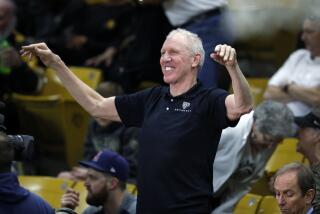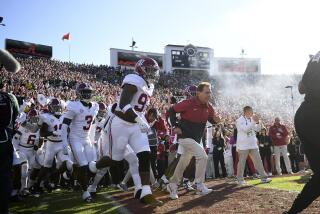The Great Barrier
LEXINGTON, Ky. â It took a while for Greg Page to die, lying in that hospital bed more than a month, hooked to a machine.
The kid from a small mining town in eastern Kentucky was so strong, bigger than life, no one could quite fathom what had happened.
A simple pursuit drill at football practice, players in shoulder pads and shorts, running three-quarter speed. Maybe someone tripped him from behind and he hit the ballcarrier funny. Maybe he slipped and someone fell on him at just the wrong angle.
After he finally stopped breathing, his best friend Nat Northington went back to the dorms and packed a suitcase. It was 1967. Page and Northington were the only blacks on the University of Kentucky varsity, the only blacks in all of the Southeastern Conference.
Most teams around the country had integrated. But the SEC was different, a bastion of college football with campuses in places such as Tuscaloosa, Ala., and Baton Rouge, La., where the sport was religion. A conference bound by tradition. Many called it flat-out racist.
The burden of change fell upon two sophomores. Through loneliness and awkward moments, slurs yelled by fans during freshman games, it had been Page who kept laughing, kept things light. Northington, the quiet one, could not abide that weight alone.
âI can tell you every brick in my room,â a former teammate recalls him saying. âAll I do is talk to the walls.â
Then he said: âIâm going home.â
*
The start of another college season brings a historic moment in Starkville, Miss., on Saturday. Sylvester Croom of Mississippi State will become the first black man to coach an SEC football team.
The game against Tulane -- both teams are mediocre, coming off losing seasons -- will be broadcast on national television. Countless sportscasters and columnists, radio talk show hosts and their guests, have dissected the significance of the moment.
Look how far football in the Deep South has come, they have said. Or, more often, how could this have taken so long?
There have been references to a 1970 game in Birmingham, Ala., where USC fullback Sam âBamâ Cunningham bowled over an all-white Alabama team, which supposedly prompted legendary Crimson Tide Coach Paul âBearâ Bryant to start recruiting blacks.
People forget that Alabama, ruler of the SEC, already had a black freshman on the roster. They forget about Page and Northington, who had quietly braved the color barrier years earlier.
âItâs been a long time,â says Jeff Van Note, who played on that Kentucky team. âThe memory dims.â
Another thing. Kentuckyâs grand experiment ended almost as soon as it began -- one player dead, the other gone home after a few games -- so people might have figured it was a bust.
If so, they figured wrong.
*
By the fall of 1965, there were whispers that the SEC would have to desegregate sooner or later. If nothing else, its teams were getting beat by integrated squads from across the nation.
Kentucky, the conferenceâs northernmost campus, was a logical place to start. Blacks had been attending the school for more than a decade. The president, John Oswald, was Minnesota-born and California-educated, an outsider.
Still, Oswald realized the first step would be risky.
The Ku Klux Klan had murdered three civil rights workers in Mississippi the previous June. In March 1965, police attacked a voting rights march in Selma, Ala., beating scores of protesters.
Within the SEC, several of the member schools were holding out for segregation, says Russell Rice, who worked two decades for the Kentucky athletic department.
âYou canât imagine how it was in those days,â Rice says. âIt was rough.â
So rough that, as Rice tells it, Oswald made an unusual offer to his football coach: If Charlie Bradshaw would recruit black players, the university would guarantee him employment for life, even if he was fired as coach.
Bradshaw, an Alabama native who played for Bear Bryant in the late 1940s, had further incentive.
âHe was losing a lot of games,â Rice says. âWeâre talking about [recruiting] good ballplayers ... they couldnât do anything but help the team.â
The players he chose would find themselves under a microscope. They would have to be good students and model citizens, able to withstand the pressure.
By December 1965, Bradshaw had found two candidates.
The arrival of Page and Northington at summer camp in 1966 was a jolt. No one was hostile, at least not openly, but some on the team had come from segregated high schools, had never played alongside blacks.
Page helped ease the tension.
An all-state defensive end from Middlesboro, down in the Cumberland Gap, he was âa very good athlete ... you could tell he was going to be a good football player,â recalls Van Note, the teamâs leader on defense.
There was also his personality, even larger than his 6-foot-2, 200-pound frame. âJust a good old mountain boy from east Kentucky,â Rice says. âA pretty down-to-Earth fella, he fit in real well.â
Northington was different, smaller, an âAâ student from up the highway in Louisville.
âNot the type who opened up,â says Van Note, who later played for the Atlanta Falcons. âAn educated player. Deep into his own thoughts.â
In those days, college athletes could not play varsity as freshmen. Page and Northington used that first season to adjust, practicing, playing a few exhibition games with the frosh squad.
One more thing -- no one realized the importance of this until later -- they helped Bradshaw sign three more black high school recruits.
âIf weâre going to do this,â Page told them, âweâll need help.â
That was enough to persuade Wilbur Hackett, a high school All-American linebacker headed for Michigan State. He agreed to attend Kentucky the following season.
âThere are times when I think about Greg and it still brings tears to my eyes,â Hackett says. âHe was probably one of the most gentle giants you would ever want to meet.â
The winter of 1966 brought one more noteworthy event on the Kentucky campus. The schoolâs all-white basketball team, under legendary Coach Adolph Rupp, lost in the NCAA championship game to a Texas Western squad that started five black players.
Sports in the Deep South were nudged a little closer to integration.
*
As soon as Hackett arrived at training camp in the summer of 1967, he understood why Page had asked for help.
âWe were kind of kept apart from the other students,â he says. âThere was also the acceptance from players. For the most part it was pretty good, but you could tell there was reluctance from some players. They never knew black players. Never played against them, never went to school with them.â
Oswald, the president, made a point of checking in with the black players. Page and Northington had found other ways to cope.
âThey were super tight,â Hackett says. âThey helped each other and they were always talking to us.â
The sophomores were now eligible. Page, listed as second-string behind Van Note, was expected to play in the season opener against Indiana and officially break the SECâs color barrier.
But everything changed on a sweltering August afternoon.
It was a drill Kentucky ran every day, the defense lined up against a skeleton offense, a coach throwing the ball right or left. The defenders were supposed to pursue the ballcarrier, give him a bump, then stop.
âI still donât know what happened,â Van Note says. âIt was such a freak thing.â
There was a pileup and, when it cleared, Page remained on the ground.
As he lay paralyzed in the hospital, a stunned Kentucky lost to Indiana, 12-10. Northington was the one who broke the color barrier, playing at defensive back. A week later, he made further history by appearing in a conference game against Mississippi.
But teammates could tell he was distraught, even quieter than usual. Van Note tried to talk to him, with no luck.
After Page died in late September, Northington showed up at the dorm room where Hackett and another black freshman, Houston Hogg, lived. His bags were packed.
âIâve got to leave,â he told them. âBut yâall have got to carry on.â
Back home, everyone told Hackett to quit. People said: âMan, they killed Greg. They killed Greg Page.â
Hackett knew that wasnât true. Still, he wavered. Almost 40 years later, he says that small things kept him in Lexington.
He recalls Coach Bradshaw sitting him down, looking him in the eye and saying: âI wonât let anything happen to you.â
He recalls a game the next season, when he was eligible to play and had earned a starting spot at linebacker. Kentucky was on the road against Mississippi.
The week of the game, a black friend gave him a âgood luckâ card on which she had scribbled pictures of dogs, guns and a noose. It was a joke, but, as the team left for the Deep South, Hackett and Hogg stayed in their room, frightened. A team manager had to coax them onto the plane.
At the stadium in Jackson, Miss., fans yelled racial slurs. The Kentucky team tried to laugh it off.
âWe were getting death threats and we were just kids,â Van Note says. âWe told Hack, âWhen you call the defensive signals, make sure you stand away from the huddle.â â
State troopers ringed the Kentucky bench, but, according to Rice, even they made snide remarks, telling Hackett whenever he came off the field: âHey, Clyde, canât you take it?â
Then came a play when Hackett broke into the Ole Miss backfield and sacked famed quarterback Archie Manning. For a moment he froze, wondering what the crowd might do.
Manning jumped up, helped Hackett up and told him: âNice hit.â
âEveryone in the stadium could see what was going on,â he says. âYou needed to have that kind of support or you didnât make it.â
Nevertheless, almost 40 years later, he wonders. How much easier would it have been to attend Michigan State?
âYou always have those thoughts,â he says. âI think about what Nat told me.â
*
A reporter calls Northingtonâs home in Indiana, just across the Ohio River from Louisville, and a woman says politely: âI donât think heâll be giving you a story.â
Hackett isnât surprised. With all the commotion about Sylvester Croomâs debut as Mississippi State coach, he has been thinking of his old friend and recently phoned to arrange a lunch.
âTo this day, he doesnât really talk about what happened,â Hackett says. âHeâll say it was a tough time, but thatâs about it.â
After leaving Kentucky, Northington enrolled at tiny Western Kentucky. He played football there, but few noticed.
Hackett was a three-year starter and, eventually, captain of the Kentucky defense. By his senior season, teams across the SEC were recruiting blacks.
âTimes were changing,â he says. âSlowly. Itâs typical of the South.â
Maybe it took too long for someone like Croom to get a head coaching job in the conference. But these days, Hackett officiates SEC football games and doesnât take for granted seeing so many blacks on the field.
It makes him think back.
âWho was going to be first?â he says. âIt was Nat and Greg who made history. Broke the ice. People forget about them.â
In 1979, the university honored Page by putting his name on a student apartment complex, a circle of modest wood-and-brick buildings across from the football stadium. There is a bronze plaque with Pageâs likeness, but it is set apart, somewhat obscured by trees and shrubbery.
On a late summer morning with rain threatening, students hurry to and from classes. Many of them know about Croom and Saturdayâs game -- at least, the football fans do -- but Pageâs name stops them cold.
Out of a dozen or so kids hanging around on a balcony, joking loudly, only one hazards a guess.
âHe died in a dorm fire, right?â says Tracey Adkins, an 18-year-old biotechnology major. âHe was the first something.â
More to Read
Go beyond the scoreboard
Get the latest on L.A.'s teams in the daily Sports Report newsletter.
You may occasionally receive promotional content from the Los Angeles Times.







